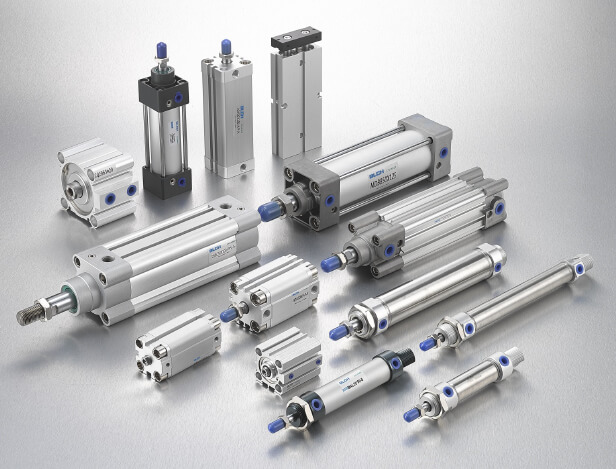
Reed sensors have been in use for many years and are the most common type used in pneumatic cylinders. They're cost-effective and versatile, although typically slower and less resistant in extreme environments.
A reed switch is a simple form of magnetic proximity sensor, comprising a pair of ferromagnetic nickel and iron reeds mounted axially inside a hermetically sealed glass tube. When no magnetic field is present, the metal reeds remain separate, in the OFF position. As the cylinder-mounted magnet approaches, the sensor generates a magnetic field parallel to it, switching to the ON position when a strong enough magnetic field attracts the metal reeds together.
Reed sensors usually last for at least 10 million switching cycles, and they're inexpensive to acquire and install. They can function with either AC or DC electrical loads and require no standby power.
Conversely, they're comparatively slow, and may not work well with high-speed applications. As they're mechanical devices that contain moving parts, they will eventually fail after a finite number of switching cycles. Using them with high-current loads will also reduce their life expectancy. The main concern for reed switches is that they can be unstable in applications that deliver high shock and vibration frequency.
There are three types of electromagnetic sensor:
Anisotropic Magnetoresistive (AMR)
Giant Magnetoresistive (GMR)
Hall-Effect (HE)
These are solid-state devices that use semiconductors instead of mechanical parts. This makes them easier to mount, faster to react, longer-lasting and more resistant to vibration and shock.
Electromagnetic sensors work by transforming a measurable physical quantity into an electrical output signal. An HE sensor has a continuous electrical current flowing through a semiconductor. A radial magnetic field applied to the sensor causes the charged electrons within it to separate, and induce an output voltage across the HE circuit. The sensor is switched to the ON position when this voltage exceeds the switching threshold.
AMR and GMR sensors can apply a magnetic field either axially or radially, changing the electrical circuit's resistance properties to create a higher voltage gradient as the magnetic field increases.
These types of sensor are fast-acting, have no mechanical parts to wear out, and are much more resilient to shock and vibration. They're less sensitive than HE sensors and can detect weaker magnet fields, allowing better detection of piston movement over greater distances. AMR sensors are cost-competitive and more compact than reed switches, while GMR sensors are even more sensitive and can be even more compact. This makes them a good choice for smaller or shorter cylinders.
AMR sensors usually draw current continuously and are not so well suited to low-power applications. The high sensitivity of GMR sensors is beneficial for applications requiring immediate sensor feedback, but they may be disturbed by nearby magnetic fields of other machinery and thus cause unintended output signalling.
Reed sensors are still the most popular and will work for most common applications. Their technology has worked well over time, and their life cycle and vibration resistance have mostly been adequate. For more specialised applications, you'll need to take into account what environment your cylinder will be exposed to. Factors include the use of enclosed clean environments, extremes of temperature, and vibration and shocks.
For solid-state devices, you'll need to consider whether the output switching speed is critical to your application, and what output signal type your control system requires: PNP (positive) or NPN (negative).
The type of sensor you choose must have current requirements and switching power compatible with your control system. It must also incorporate any necessary circuit protections. You'll need to take mounting options into account according to your cylinder type, and magnet orientation to the piston if you choose a reed switch or HE sensor.
The final consideration is the power supply wiring to the sensor, as miswiring the sensor can permanently damage it. Solid-state (AMR, GMR, HE) sensors usually have a three-wire configuration; reed switches use two-wire.
Most people will go with a reed switch sensor for the usual run of machine applications, but more complex applications and automated systems may demand a more responsive solution. Considerations of space, power and responsiveness will all depend on its working environment, while cost-effectiveness is always a factor.
(From the internet)